U.S. Department of Transportation
Federal Highway Administration
1200 New Jersey Avenue, SE
Washington, DC 20590
202-366-4000
Missouri Division
Long Lasting
Innovative
Fast Construction
Efficient and safe
Three national surveys conducted in 2000 found that "improvements in traffic flow, pavement conditions, and work zones may result in the greatest rise in traveler satisfaction. Work zones are especially critical as travelers view road repairs as a major reason for traffic delays."
Technology and practices needed to achieve improved safety, reduced congestion due to construction, and improved quality have been proven, but have seen only sporadic use.
Absent dramatic changes in our approach to promoting technology and innovation, realizing the full potential of these advancements will take decades.
Our stakeholders are demanding national leadership.
We have conceived a plan that will bring about a tremendous leap forward in highway construction practices, instead of the creep that is currently ongoing.
Highways for LIFE is not simply a program of building a few projects, it is a way increasing the return on all of our future highway construction investments.
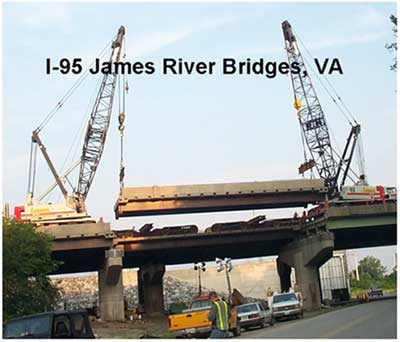
I-95/James River Bridges, VA.
VDOT opted for night-only construction, most of which occurred between 7 PM and 6 AM Sunday through Thursday nights. During nighttime construction, one lane of traffic was kept open in each direction. Under typical construction approaches, construction would have been completed in about three years. With the use of prefabricated and assembled composite units, as well as high-performance concrete, the project was completed in seven months, and at cost 12 percent lower than traditional methods.
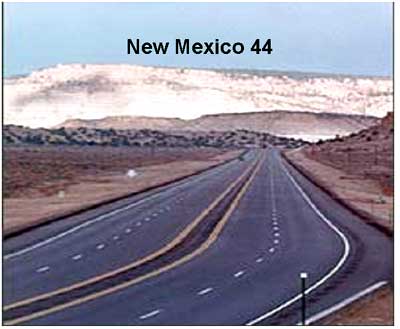
New Mexico 44:
FYI: NM 44 involved innovative financing and a 20 warranty. Both of these techniques are in the Tool Box, but, are not Highways for LIFE requirements
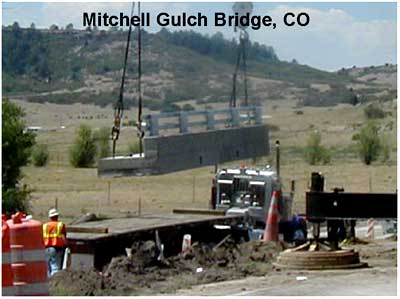
Mitchell Gulch Bridge, Denver, CO
Crew Completes New Crossing in Two Days, not Two Months
Utilize proven success
I have just given you a few of many examples
Involve new stakeholders
Beyond FHWA, States/AASHTO and Industry
Include the suppliers, consultants and users
Do the never been done
Not inconsistent with "utilize proven success" Refers to the "boxes" and "limitations" that we traditionally take as givens, but can be easily changed simply by changing our attitude, i.e., changing "I can´t" to "I can".
Be bold and Audacious
Leap rather than creep
Highways for Life Vision:
In 4 years, widely demonstrate dramatic improvement in the American driving experience
Highway for Life Goals
Improve safety
Reduce congestion due to construction
Improved quality
Highways for Life: Key Elements
As leaders, DOT/FHWA must:
Establish the Highways for LIFE vision
Fully engage all key stakeholders in development and implementation
Lastly, communicate to the full highway community and public
We are looking to the stakeholders to help us determine how best to accomplish the Highways for LIFE vision and goals
Specifically we intend to involve the stakeholders in the development of the Highways for LIFE Roadmap, Performance Standards and Tool Box.
The Highways for LIFE Performance Standards are targeted on:
Why we believe that performance standards are needed
Very preliminary examples are:
Safety
Quality
The Highways for LIFE Tool Box will contain the best in:
These tools are to assist the owners and industry in achieving the Highways for LIFE Performance Standards
Use of the Highways for LIFE tools is not mandatory for Highways for LIFE projects
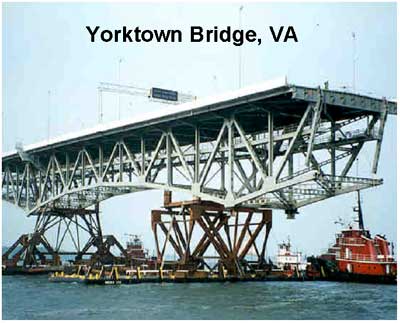
George P. Coleman Bridge Yorktown, VA
In 1995, the largest double-swing bridge in the United States was dismantled and replaced in record time. A major goal was limiting bridge closure to avoid disrupting traffic of more than 27,000 vehicles a day. Lighter-weight modern materials allowed Virginia DOT designers to widen the new bridge but use the existing foundation. While approach spans were widened, truss spans were prefabricated nearby and then barged to the construction site.
Six old spans were removed and six new ones placed in only nine days.
The old bridge was opened in 1952, it was two lanes with no shoulders.
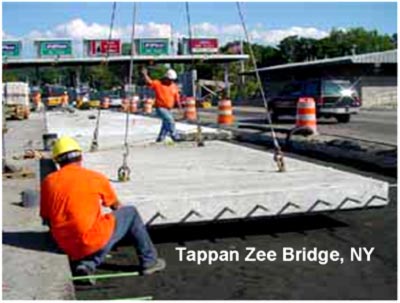
Tappan Zee Bridge, I-287,: NY
Reconstruction of the toll plaza pavement. Approximately 20,000 sq yds of pavement were replaced in a little over four weeks with no disruption of rush hour traffic.
Communication and outreach to the full highway community and the public are essential to achieving the Highways for LIFE goals and in sustaining the momentum once the pilot program is completed.
Highway Projected Investment: $1 Billion
Showcase Projects
Provide additional partial funding for approximately 100 projects
Innovations for Technology Partnerships
Partial funding to taken proven technologies (from other industries and internationally) and further develop them for application.
Paradigm Shift
Includes technology transfer, training for the public and private sector, education efforts from trade schools to graduate school, demonstrations, workshops, knowledge system, technical assistance, communication and outreach.